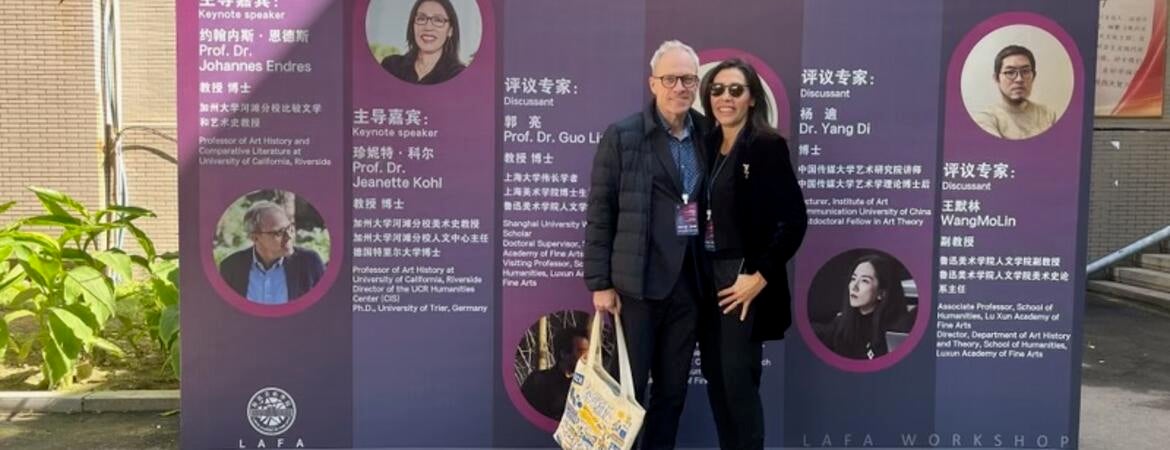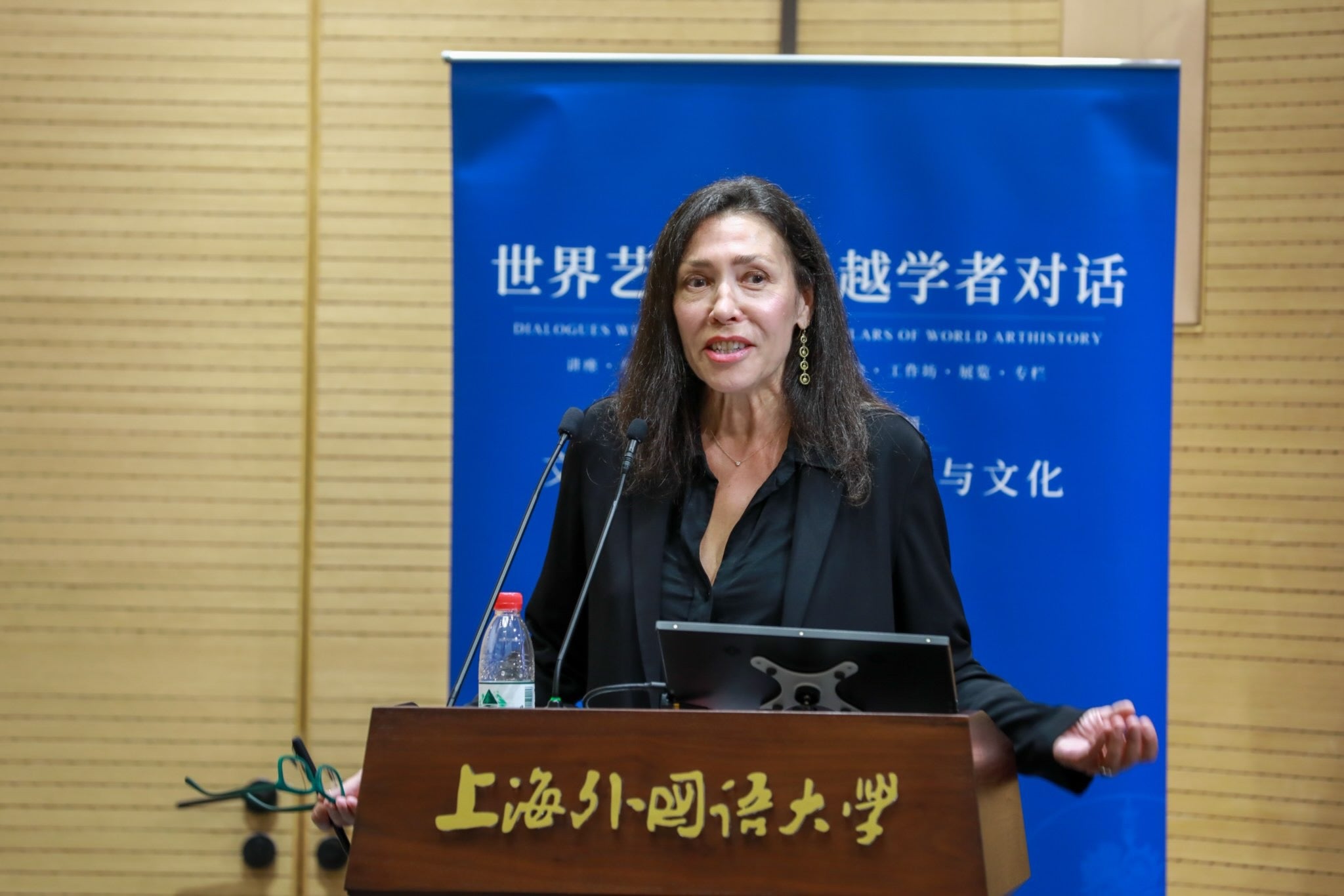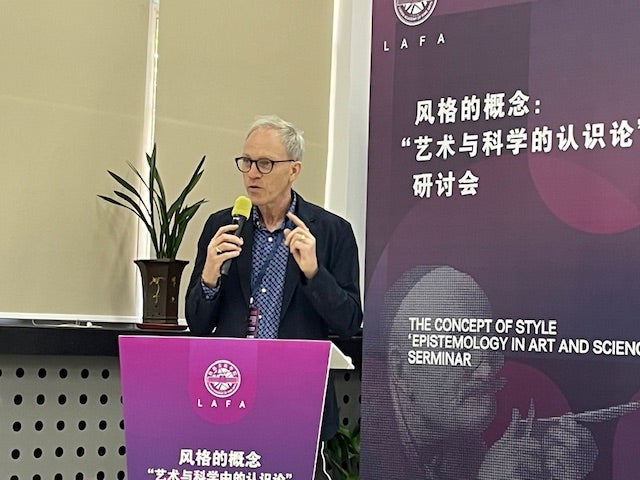College of Humanities, Arts, and Social Sciences

UC Riverside’s Jeanette Kohl, associate professor of art history, concluded the 2023-24 World Art History Institute’s (WAI) Distinguished Lecture Series on Renaissance Art and Culture during a September trip to China. As a distinguished visiting professor, Kohl delivered the closing lecture at Shanghai International Studies University (SISU), following a series of presentations and a two-day workshop that explored new perspectives of art history and culture during a two-week visit spanning three cities.
“It was a particular honor to give the closing lecture for a year-long series with such esteemed international scholars,” Kohl said. Kohl, who also serves as co-director for UCR’s Center for Ideas and Society (CIS), was invited by Chinese art historian LaoZhu, the founder of WAI.
This year’s series, “Dialogues with Distinguished Scholars of World Art History,” brought together 12 experts in European Renaissance art from the U.S. and Europe for monthly lectures to foster dialogue between Eastern and Western perspectives on art history. Kohl was also accompanied by her husband and UCR colleague, Johannes Endres, professor of art history and comparative literature, who also delivered a keynote and co-led a workshop with Kohl at the Lu Xun Academy of Fine Arts (LAFA) in Shenyang, China.
Closing the lecture series, Kohl presented her keynote lecture, “A Murder, a Mummy, and a Bust – Forensics of a Renaissance Portrait Sculpture,” at SISU. The lecture highlighted Kohl’s approach to Renaissance art, using the bust of Simon of Trent – an object closely linked to anti-Semitic persecution during the late 15th century – as an example.
“I presented new conservatory and iconographic evidence for the object as a key work in the ferocious, anti-Semitic propaganda around the Trent blood libel of 1475,” she said. “The unusual object is a particularly suited object to talk about the role of visual and conservatory observation, knowledge of historical contexts, and questions of methodology in Renaissance art history.”
Prior to her lecture at SISU, Kohl also spoke at the School of Arts at Peking University in Beijing, the third-ranked university in China, in a hybrid presentation with both in-person and virtual audiences. Kohl’s lecture, “Thinking with Busts: Rembrandt’s Aristotle with the Bust of Homer,” amassed a virtual attendance of 12,000 viewers on Zoom.
“This lecture was a unique experience and left a big impression on me,” she said. “Probably the largest audience I will ever reach with a single presentation.”
Kohl’s lecture at Peking University was based on the last chapter of her latest book, “The Life of Bust,” currently in press with Brepols Publishers.
“I spoke about the artistic and ‘phenomenological’ significance of sculpted portraits as a key medium of remembrance that touches humans in unique intellectual and sensory ways,” she said, examining Rembrandt’s famous painting depicting Aristotle as he contemplates a bust of Homer.
Kohl and Endres engaged with 16 students who presented their papers on Western art traditions in a two-day, “student-centered” workshop at the LAFA. Proposed by Endres, the workshop’s topic, “The Concept of Style: Epistemologies in Art and Science,” is closely related to his research on 19th-century European art and literature.
“The workshop was a great success,” Endres said. “I was thrilled to see how interested our hosts and their students were in our research, and especially in the Western disciplinary methodologies of our common field of art history.”
“I was positively surprised by the students’ open-mindedness, excellent preparation of their papers, their dedication to their topics, and the huge interest in European academic traditions – quite different from the U.S.,” Kohl said. “There was a completely open intellectual exchange, both with colleagues and students, about what is going well and what is going not so well on U.S. campuses and in China.”
For Kohl and Endres, the workshop was eye-opening in the differences between academia in the U.S. and China, even down to student approaches to resources used for study. Both were impressed by the students’ dedication to understanding foreign texts and their proficiency in various languages.
“Interest in primary textual and visual sources is strong, and we were absolutely taken with the tremendous generosity and hospitality in all three locations, but especially in Shenyang,” Kohl said.
“Their enthusiasm for learning from us was contagious and amazed my wife and me wherever we went on our trip and whatever we did and saw,” Endres said. “In return, they brought us into their country and their academic lives and took us on exciting excursions into the great history of their art and culture.”
At the LAFA workshop, Endres was also invited to speak in a keynote address on “Style in an Interdisciplinary Perspective,” aimed at exploring the evolution of style as a concept across art, science, and other fields. Endres, who has researched the concept of “style” at length, has traced how style has grown from a term used in art and literary criticism about the cultural shaping of work to a broader intellectual framework on discourse in reasoning in different disciplines.
“In my talk, I was therefore interested in exploring new ways of looking at the relationships between cultural and scientific knowledge formations and their disciplinary production in different fields and objects, such as works of art, literary texts, music, and scientific epistemologies,” he said.
Speaking and co-leading the workshop at LAFA left Endres with new perspectives and questions for his research. “I learned a great deal from their questions and presentations and from their different cultural backgrounds, as they shared a common interest in questions of style and form in art,” he said.
“There is much to be gained, not least on the academic level, from meeting each other at eye level and cultivating an interest in our respective histories and values,” he said.
For Endres and Kohl, it was also an opportunity to represent UCR, as both members of the University of California and scholars of European art and culture.
“Visits and conversations like these are invaluable,” Kohl said. “We need to leave our own academic and national bubbles and actually talk to colleagues in other cultures, connect with their traditions, respect them, and bring an open mind to learn from them and their histories.”
According to Kohl, their two weeks in China were not merely an academic visit but a full cultural immersion. Outside of lectures and presentations, the visit offered Kohl and Endres opportunities to explore local cuisine, museums, and historic sites with tour guides by their side.
“It is such a modern and forward-pushing society, in many ways, and the state of digitization, the cutting-edge technology, and the pride of their own long cultural traditions was palpable everywhere,” Kohl said.
Following their trip, Kohl is motivated to continue working with her colleagues in China by collaborating with them on her new project, “Global Faces,” which examines the various styles of portraiture across cultures during the Renaissance period.
Kohl and Endres hope their visit will strengthen much-needed international academic ties for students and colleagues.
“This is so important,” she said. “If you go places, you learn to understand people in those places, how and why they think differently, act differently, and have different expectations.”
She hopes UCR will welcome more international scholars from across the world.
With funding support from Marko Princevak, UCR’s Vice Provost for International Affairs, UCR recently launched CIS’s first Visiting International Scholars program, which Kohl sees as a promising beginning.
“We are bringing in a Finnish media archaeologist, Jussi Parikka, who has a large international following – a real star in his field,” Kohl said. Parikka will lead a workshop for students and participate in a day-long symposium titled “Operativity and Digital Capture” at UCR Arts in January 2025, an event she hopes will be the first of the series fostering global academic exchange at UCR.
“So – stay tuned,” she said. “There is more to come!”


FEATURED PHOTO. Johannes Endres and Jeanette Kohl at the Lu Xun Academy of Fine Arts (LAFA) workshop.